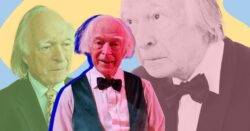I’ve no thoughts of stopping yet, and must now have memorised around 50 routines at least (Picture: Denis Noble)
Looking around The Blackpool Tower Ballroom, I couldn’t believe I was there.
It was an amazing feeling to be on that magnificent, iconic dance floor that we’re all familiar with.
Only two years earlier, I’d started ballroom dancing for the very first time – at the grand age of 83.
Now, I’d made it onto the biggest stage of all.
Here I was dancing the Broadway Quickstep, with my moves even being recorded by Phil Hurst of Hurst Dance Studios as part of a publicity video for his website.
I, along with others, performed in unison. And it felt exhilarating.
It wasn’t my first brush with dancing, however – that came much earlier in life.
I was eight years old when World War 2 ended. The war had completely destroyed my home.
A huge bomb – probably destined for Clapham Junction – missed its target and somehow fell on our family terrace in Southwest London.
We were left homeless and were forced to move to temporary accommodation. It was a miracle that we survived.
Progress was slow and confusing if I’m honest (Picture: Denis Noble)
My parents, George and Ethel – both poor working tailors – always wondered what I’d grow up to be. My father loved the stage, so sent me off to learn tap dancing at the age of nine.
I felt excited, yet, en route to a class, two older boys spotted my case that housed my dancing shoes. Amongst cries of ‘dancing is for girls!’, they mugged me and ripped open the bag.
The incident brought my experiment with dancing lessons to a quick end.
I was upset that my parents had paid for those shoes and the case, only to see them destroyed. They didn’t even try to convince me to go again because they must have sensed that I was frightened.
For me, it was the science world that I was destined to enter instead. In 1955, I was admitted as a medical student to University College London.
I may not have been dancing, but I still kept fit. I had no choice – it was 20 miles each day to the university each day and I couldn’t afford the bus or underground, so I had to cycle instead.
I found it hard to gain confidence at something completely new (Picture: Denis Noble)
A busy career followed. I became a biologist who developed the first mathematical model of cardiac cells in 1960, and held the Burdon Sanderson Chair of Cardiovascular Physiology at the University of Oxford from 1984 to 2004.
I retired in 2004, although I am still active in the field today as the co-founder of The Oxford Longevity Project. I founded the project with other scientists to discuss scientific breakthroughs around ageing, so I knew the importance of staying fit and taking care of myself in my later years. I decided to take up swimming to help me do this.
However, when the pandemic arrived, I knew this beloved habit would have to stop. It was too dangerous to be in crowded changing rooms and close contact with others. So what could I do instead?
A colleague of mine, Director of Voices from Oxford, Dr Sung Hee Kim – who happened to be a prize-winning dancer – suggested I should take up ballroom dancing, and offered me the chance to practise on her large kitchen floor.
Soon, I couldn’t resist trying some of the more popular dance routines (Picture: Denis Noble)
We had formed a working ‘bubble’ during the pandemic, so it seemed to be a great solution.
Progress was slow and confusing if I’m honest. I found it hard to gain confidence at something completely new as I mainly tried to learn from YouTube video lessons.
But, when the pandemic rules relaxed, it got easier as I could then be taught in person and I decided to finally start regular lessons with Bruce Richardson, the Oxford University Dancesport Club’s Head Coach.
Bruce teaches all forms of ballroom. From him I have learnt wonderful routines for the Waltz, Quickstep, Foxtrot, Tango, and even the Paso Doble (a spectacular Franco-Spanish dance based on a bullfight).
I first imagined that a few lessons would be sufficient but then, I got hooked on the challenge and slowly learnt that, just like being a musician, regular teaching is best.
I noticed I was probably the oldest at most dance events, but it doesn’t feel that way! (Picture: Denis Noble)
I still do four hours a week of training with Bruce now. Except, I was told that simply learning with a coach is never enough, you must go to events – so that was my next step!
One of my first event experiences, at a Silver Slippers Dance event in Didcot, certainly knocked my confidence. The standard of nearly everyone else was much higher than mine and clearly the result of many years of practice – but, then again, I’d only started dancing in my eighties.
It spurred me on: if they could do it, surely anyone could?
Soon, I couldn’t resist trying some of the more popular dance routines at classes and events – taking on the Argentine Stroll, a complex tango sequence dance.
People have been very welcoming to this strange phenomenon of an 86 year old university professor joining in with their tea dances and balls.
But after my first event, I noticed I was probably the oldest at most dance events, but it doesn’t feel that way!
My energy and drive when motivated to perform well suggest that of a 50 year old, and Bruce has trained me to ‘step out’, so reaching long – spectacular dancers take long steps in dances like the Waltz, Foxtrot and Quickstep.
When I dance, it is exhilarating and if it doesn’t go as well as I’d like, I know there’s always room to improve.
I recently participated in Maureen Stewart’s Strictly Fun Dancing events near Blackpool and in Scotland, where I learnt the Platinum Waltz and the Coronation Waltz – both sequences created for the jubilee and coronation – which was great fun.
I’ve no thoughts of stopping yet, and must now have memorised around 50 routines at least. It’s unbelievably fun and a great memory challenge.
People sometimes say: ‘You are as old as you feel’. Well, I guess I feel 56!
Age is Just a Number
Welcome to Age is Just a Number, a Metro.co.uk series aiming to show that, when it comes to living your life, achieving your dreams, and being who you want to be, the date on your birth certificate means nothing.
Each week, prepare to meet amazing people doing stereotype-defying things, at all stages of life.
If you have a story to share, email emmie.harrison-west@metro.co.uk
MORE : After a divorce at 41, I channeled my anger into boxing
MORE : I’ve raised £100,000 for charity over 50 years – all through knitting
MORE : It took me 47 years to come out to myself – and 3 more years before I told my best friends
After my first event, I noticed I was probably the oldest at most dance events, but it doesn’t feel that way!





